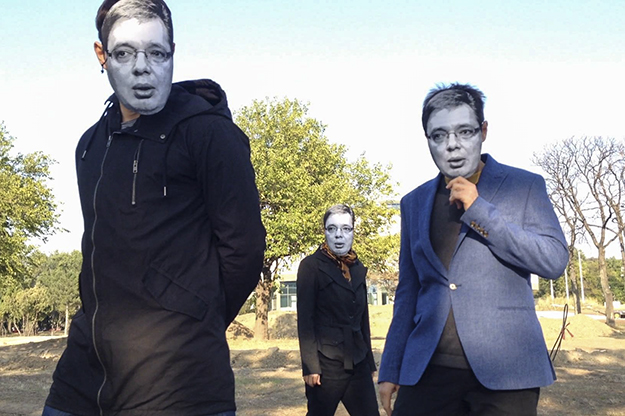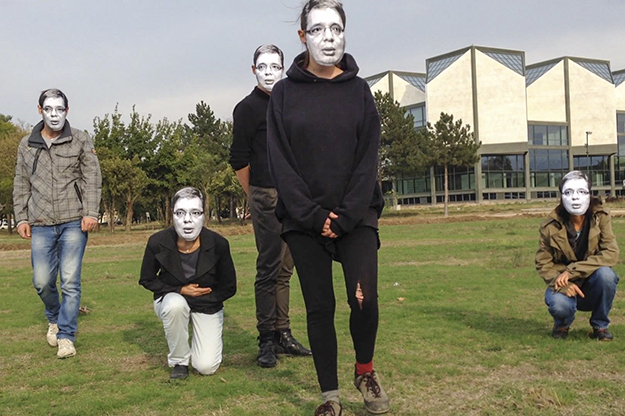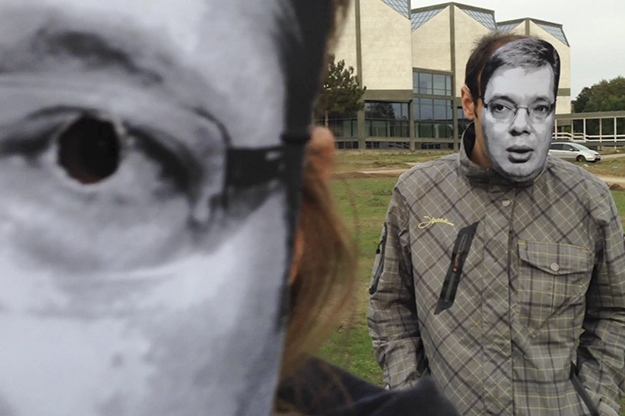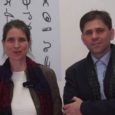On the first day of the spectacularly announced seven-day opening of the Museum of Contemporary Arts in Belgrade (MSUB) on Oct. 20th 2017, two artists were detained for conducting performances in which photos of the president of Serbia, Aleksandar Vucic, were used.
One of them, coauthor of this blog Vladan Jeremic, is a member of the ArtLeaks platform and one of the organizers of a series of events titled “The Salon of the Unbribables.” The second artist is Uros Jovanovic, an independent artist and performer.
The first to be arrested was Jeremic. Detectives working at the opening suspected him of “insulting the president” and turned him over to the police, who confiscated his personal documents and materials for the show (in this instance, paper masks and flyers).
Jovanovic was arrested later, when he attempted to enter the museum with a photo of the president of Serbia in a gold-plated frame, to complement a previously provided statement to the media that “Vucic is the best artist.” The state prosecutor decided to release them both after a few hours of interrogation.
The artists were putting on a performance in front of the museum entitled “Unbribable,” which was conducted as part of the “The Salon of the Unbribables” program. Visitors attending the opening were encouraged to take and put on paper masks bearing the face of the Serbian president. They also received flyers which contained a photocopy of a sandwich. The audience mostly reacted in a positive manner, recognizing a visual metaphor of the social and political situation most people in Serbia find themselves in.

Photo courtesy of the Unbribables
“The Salon of the Unbribables” was set in motion by Tony Maslic, Nikola Radivojevic, Rena Raedle, and Vladan Jeremic, posing the following question: Is being unbribable possible in an environment where it is claimed that everything and everybody has a price?
Through a variety of programs, above all by presenting the fourth edition of the ArtLeaks Gazette through the “Dimensions of Bribability” exhibition conducted in Belgrade’s MKM gallery, “unbribable” positions of all forms and expressions were showcased within the Salon without any particular spatial and time limits.
Being “unbribable” is not treated as a value in which people wish to obtain some kind of moral highground. In the words of the organizers: “These unbribable positions go beyond the imagination of the ‘Vu-totality’ that surrounds us, and think of “unbribability” as essential to their action. Therefore, the practise of unbribability is in contradiction with the Real. The Salon of the Unbribables is born out of the situation when artists in Serbia are deprived of space and a voice. Being unbribable is a form of protest against the power game with its give and take dictated by the bloc in power. Let’s be unbribable here and now, when ‘Vu-totality’ establishes hegemony in the field of culture and art.”
Just after the incident took place, the attitude of the Museum as a state-run institution was still not clear. The general impression is that the Museum was actually “kidnapped” by the authorities, since the opening event was co-organized by the Government of Serbia and the Museum. We had the impression that the spectacular opening was actually just a celebration of the chosen few, where local artists and independent cultural initiatives were not that welcome.
A variety of invitations to the opening were sent out, one to the party for the ruling elite, and others for visiting the museum which would anyhow be open and available to all — invitations that were not necessary in the first place.
Construction work in the park around the Museum and the celebration protocol pointed to the fact that much had been arranged in a way to comply with the infrastructure surrounding the seven-day celebration. An example of this were the new concrete paths made for the ceremony of opening the museum.
One led straight from the museum to the “Usce” Business Center, where the “Top of the Hub” restaurant is located and where on the first day of opening to the public, the political and media elites had their own separate celebration and press conference. This event was attended by the Serbian president Aleksandar Vucic and prime minister Ana Brnabic with their respective partners, alongside many others.

Photo courtesy of the Unbribables
Seven days after the incident took place, the director and curators of the museum have finally publicly expressed their opinions regarding the detention of the artists, after being pressed by journalists at a press conference on Oct. 27. But the contradictory statements of the MSUB administration shed new light on the Museum’s and security system’s role with regards to the detention of the artists and the disturbance of visitors.
It is a good thing that the Museum curators supported the artistic performance, stating that detaining artists constitutes an attack on the freedom of artistic expression, a point emphasized by the curator and author of the exhibition in the Museum, Dejan Sretenovic.
It is worrisome, however, that the acting director of the Museum, Slobodan Nakarad, did not support Sretenovic’s view, describing the introduction of the president’s photos as a danger to the museum’s property and the audience, and a form of art outside of the “norms that are part of our civilization.”
Even after the state prosecutor established that there is no evidence for the violation of laws with regards to the performances in which the president’s photo was used, Nakarada did not condemn the detention of the artists, or their censorship.
One important detail the Museum representatives should be aware of, but are still silent about, is that it was private security company placed at the entrance that raised the alert due to a paper mask and flyers displaying a photo of a sandwich.
These materials from the performance were taken out of a purse of a visitor at the museum door. She was later sent to the police to establish her identity. As an organizer of the performance, Vladan Jeremic decided to find out what was going on, since he noticed that visitors were being harassed for possessing those materials, after which he was detained.
Curators have attempted to reject all responsibility for the arrest, and pointed out that they were present at the questioning of Vladan Jeremic, but that they could not do anything. Despite the fact that the artistic action as part of the “The Salon of the Unbribables” was largely announced in the media, and one of the curators was also personally introduced to the idea, museum representatives claimed that they did not know the planned artistic activities were scheduled, as well as that the detention of Jeremic was done outside of the Museum’s territory, which is not true.
Institution representatives and responsible authorities have so far not given statements regarding a series of additional accusations that have lit up social networks. For example, that private security searched the belongings of visitors, looking for pieces of paper, notebooks, flyers, and cardboard (one visitor, an artist and curator from Denmark, was deprived of one of his paintings, after which it was crushed and thrown away) and that people who took photos of Uros Jovanovic’s performance were asked to show their ID.
Another example of the critical observation of institutions was the “7×24 = return to home” performance by Sofija Modosanov and Jelena Jacimovic, artists who lived in the MSUB for seven days. As per the artists’ words, this intervention had the intention of “using to the full extent” and “compensating” all that was missed in the 10 years of the period when MSUB was closed.
They stated in a radio interview that “empty pieces of paper seemed to be the biggest threat for the Museum,” and that “political connotations” cannot be carried in. On the basis of all disclosed information, it may be concluded that the private security company was the main means in implementing censorship and selection of the approved and unsuitable audiences.
In all this, one general problem arises, namely, that “outsourcing” of executive competencies to private security companies has been a technique of ruling (and warfare) for a long time now, not only in many environments around the world, but also in Serbia, above all in situations in which the authorities could come into conflict with the laws of the so-called “democratic state” due to their actions.
Besides the issues of democratic control of such actions, the following questions remain: What was the general criteria for the control of visitors and sending them to be identified by the authorities; and who gave these criteria and authorizations to them?
Perhaps it was only a typical case of precautionary obedience, but maybe those measures were planned by the institutions of culture and government, as well as those who organized the opening event. This only shows the strong pressure to which institutional representatives in Serbia are exposed to.

Photo courtesy of the Unbribables
Certainly, with the unemployment and poverty which is ruling over Serbia and the entire region, everybody is primarily concerned with their own positions. However, this does not change the fact that, by behaving in this manner, public institutions give their approval to the act of censorship.
In regard to this, sociologist Milan Rakita published an article, in which he argued that after Nakarada’s statement it had become clear that the Museum, that seemed like an ideological state apparatus, now is also a repressive state apparatus.
The goal of the “Unbribables” performance was to break the wall of silence on what is regarded as the “trend of bribery.” This performance has actually generated a chain of reactions that uncovered the hierarchy of mechanisms and techniques of ruling, and stripped naked the role of institutions of culture within this apparatus: these institutions, and the Museum itself, at any given moment, functioned as part of a repressive state apparatus.
Currently, public institutions of culture in Serbia are sadly showing that they can hardly be places in which artists can critically deal with issues of the contemporary society, even though they put all their efforts to be that for their nominal liberal discourse of European integration.
Pompously opening the Museum could not hide the fact that the institutions of culture under this government in Serbia are ignorant to the concrete reality and problems of contemporary arts and society. They contribute to the normalization of the status quo that rules over Serbia, where the fear from measures of intimidation, losing a job or getting onto black lists of “public enemies” or “foreign agents” force people into silence, apathy, self-censorship, and precautionary obedience.
The situation of Serbia shows similarities between countries in which right-wing authoritative regimes are in power. In Turkey, Poland, Hungary, and Russia, cultural workers, those who work in education and art are suffering from censorship. Attacks on the autonomy of institutions of culture and education, are part of the “war on culture,” led by the right. United resistance toward those politics is desperately needed throughout Europe.
Feature image courtesy of the Unbribables.

